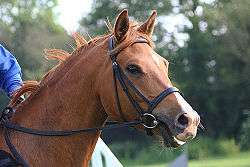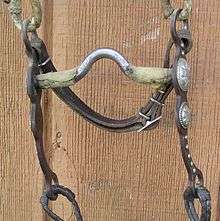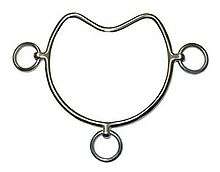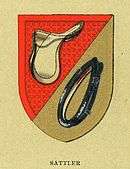Bit (horse)

A bit is a type of horse tack used in equestrian activities, usually made of metal or a synthetic material, and is placed in the mouth of a horse or other equid and assists a rider in communicating with the animal. It rests on the bars of the mouth in an interdental region where there are no teeth. It is held on a horse's head by means of a bridle and has reins attached for use by a rider.
Basic types
Although there are hundreds of design variations, the basic families of bits are defined by the way in which they use or do not use leverage. They include:
- Direct pressure bits without leverage:
- Snaffle bit: Uses a bit ring at the bit mouthpiece to apply direct pressure on the bars, tongue and corner of the mouth.
- Leverage bits:
- Curb bit: A bit that uses a type of lever called a shank that puts pressure not only on the mouth, but also on the poll and chin groove.
- Pelham bit: A single curb bit with two sets of reins attached to rings at the mouthpiece and end of the shank. Partly combines snaffle and curb pressure.
- Kimblewick or Kimberwicke: A hybrid design that uses a slight amount of mild curb leverage on a bit ring by use of set rein placement on the ring.
- Bit combinations
- A type of bridle that carries two bits, a bradoon and a curb, and is ridden with two sets of reins is called a Weymouth or double bridle, after the customary use of the Weymouth-style curb bit in a double bridle.
- Non-curb leverage designs:
- Gag bit:A bit that, depending on design, may outwardly resemble a snaffle or a curb, but with added slots or rings that provide leverage by sliding the bit up in the horse's mouth, a very severe design.
- In-hand bits are designed for leading horses only, and include the:
- Chifney Anti-Rearing Bit: This is a semi-circular-shaped bit with three rings and a port or straight mouth piece used when leading horses. The port or straight piece goes inside the mouth, and the circular part lies under the jaw. The bit is attached to separate head piece or the head collar and the lead is clipped onto the bit and headcollar to limit the severity.[1]
- Tattersall ring bit[2]
- Horse-shoe stallion bit[2]
Bits are further described by the style of mouthpiece that goes inside the horse's mouth as well as by the type of bit ring or bit shank that is outside the mouth, to which the reins are attached.
Types of headgear for horses that exert control with a noseband rather than a bit are usually called hackamores,[3] though the term "bitless bridle" has become a popular colloquialism in recent years.
History

The riders of early domesticated horses probably used some type of bitless headgear made of sinew, leather, or rope.[4] Components of the earliest headgear may be difficult to determine, as the materials would not have held up over time. For this reason, no one can say with certainty which came first, the bitted or the bitless bridle.[4] There is evidence of the use of bits, located in two sites of the Botai in ancient Kazakhstan, dated about 3500-3000 BC.[5] Nose rings appear on the equids portrayed on the Standard of Ur, circa 2600 BC - 2400 BC. To date, the earliest known artistic evidence of use of some form of bitless bridle comes in illustrations of Synian horseman, dated approximately 1400 BC.[6]
The first bits were made of rope, bone, horn, or hard wood. Metal bits came into use between 1300 and 1200 BC, originally made of bronze.[7] In modern times, nickel was a favored material until about 1940, when stainless steel largely replaced it.[8] Copper, aurigan and sweet iron (cold rolled steel) are incorporated into some bits to encourage salivation in the mouth of the horse, which encourages a softer mouth and more relaxed jaw. Bits also can be made of other materials such as rubber or plastic, sometimes in combination with metals.[9]
Throughout history, the need for control of horses in warfare drove extensive innovation in bit design, producing a variety of prototypes and styles over the centuries, from Ancient Greece into modern-day use.[10]
Design and terminology

A bit consists of two basic components, the bit mouthpiece that goes inside the horse's mouth, and the bit rings of a snaffle bit or shanks of a curb bit, to which the bridle and reins attach.
All bits act with some combination of pressure and leverage, often in conjunction with pressure applied by other parts of the bridle such as the curb chain on the chin, noseband on the jaw and face, or pressure on the poll from the headstall.[11] Particular mouthpieces do not define the type of bit. It is the sidepieces and the leverage these rings or shanks use to act on a horse's mouth that determines whether a bit is in the curb or snaffle family, and has a great impact on the severity of the mouthpiece.
The mouthpiece of a horse's bit is the first factor most people think of when assessing the severity and action of the bit. Therefore, it is carefully considered when choosing a bit for a horse. Many mouthpieces are not allowed in certain competitions. Bit mouthpieces may be single jointed, double-jointed, "mullen" (a straight bar), or have an arched port in the center of varying height, with or without joints. Some have rollers, rings or small "keys" that the horse can move with its tongue. Mouthpieces may be smooth, wire-wrapped or otherwise roughened, or of twisted wire or metal.
Various types of metal or synthetic substances are used for bit mouthpieces, which may determine how much a horse salivates or otherwise tolerates a bit; a horse having a moist mouth is considered more relaxed and responsive. Commonly used metals include stainless steel and nickel alloys, which generally do not rust and have a neutral effect on salivation; sweet iron, aurigan and copper, which generally tend to encourage salivation, and aluminum, which is considered drying and is discouraged as a mouthpiece metal. Synthetic mouthpieces may be made with or without internal metal cable or bar reinforcement. Rubber bits are generally thicker than metal bits, but other types of synthetics such as plastics are also used. Plastic-coated bits are often the same size as metal bits, and some are flavored.
Often, bits with shanks that also have single- or double-jointed mouthpieces are incorrectly referred to as snaffles. Because of the presence of a shank, they are actually in the curb bit family.
Effects
The mouthpiece of the bit does not rest on the teeth of the horse, but rather rests on the gums or "bars" of the horse's mouth in an interdental space behind the front incisors and in front of the back molars. When a horse is said to "grab the bit in its teeth" they actually mean that the horse tenses its lips and mouth against the bit to avoid the rider's commands (although some horses may actually learn to get the bit between their molars).[11]
Bits are designed to work by pressure, not pain. Depending on the style of bit, pressure can be brought to bear on the bars, tongue, and roof of the mouth, as well as the lips, chin groove and poll. Bits offer varying degrees of control and communication between rider and horse depending upon their design and on the skill of the rider. It is important that the style of bit is appropriate to the horse's needs and is fitted properly for it to function properly and be as comfortable as possible for the horse.[11]
In the wrong hands even the mildest bit can hurt the horse. Conversely, a very severe bit, in the right hands, can transmit extremely subtle, nuanced signals that cause no pain to the horse. Commands should be given with only the quietest movements of the hands, and most steering is done with the legs and seat. Thus, instead of pulling or jerking the horse's head to change direction by force, a skilled rider indicates the desired direction by tightening and loosening the grip on the reins. The calf of the leg is used to push the body of the horse in a certain direction while the other one is used as a pivot and to provide the correct amount of impulsion required to keep the horse moving. Likewise, when slowing or stopping, a rider sits deeper in the saddle and closes their hands on the reins, avoiding jerking on the horse or hauling back on the reins in a "heavy-handed" fashion. Change of position of the seat and the pressure of the rider's seat bones are also extremely useful for turning, speeding up and slowing down.
There are many factors in the bitting equation which must be considered to get a true estimate of the action and severity of a bit. Although some mouthpieces are marketed as "correction" (a euphemism for "severe") bits or "training" (implying a mild bit), the terms are relative. The bit always rests on the sensitive bars of a horse's mouth. A hard-handed rider can make even the mildest bit painful, and a skilled, light-handed rider can ride in a much harsher mouthpiece without damaging the mouth or causing any distress in the horse. Additionally, the shank or ring has a great impact on the action of the mouthpiece. Snaffles are generally considered the mildest, curbs and gags the harshest. It is difficult, therefore, to compare a harsher-type bit with a mild mouthpiece (such as a pelham with a rubber mullen mouth), and a milder-type bit with a harsher mouthpiece (like a thin snaffle with a slow twist). In general, however, the mouthpiece can have a marked difference on the severity. Snaffles with twisted wires are never considered mild, whereas a pelham with a low port could.
Snaffle or direct pressure bits

All bits work with either direct pressure or leverage. Bits that act with direct pressure on the tongue and lips are in the general category of snaffle bits. Snaffle bits most commonly have a single jointed mouthpiece and act with a nutcracker effect on the bars, tongue and occasionally roof of the mouth. However, any bit that operates only on direct pressure is a "snaffle" bit, regardless of mouthpiece.[12]
Curb or leverage bits

Bits that have shanks coming off the bit mouthpiece to create leverage that applies pressure to the poll, chin groove and mouth of the horse are in the category of curb bits. Most curb bit mouthpieces are solid without joints, ranging from a straight bar with a slight arch, called a "mullen" mouthpiece, through a "ported" bit that is slightly arched in the middle to provide tongue relief, to the full spade bit of the Vaquero style of western riding which combines both a straight bar and a very high "spoon" or "spade" extension that contacts the roof of the mouth. The length of the shank determines the degree of leverage put on the horse's head and mouth. Again, a bit with shanks and leverage is always a "curb" type bit, even when it has a jointed mouthpiece more commonly seen on a snaffle (such bits are sometimes—incorrectly—called "cowboy snaffles"). All shanked bits require the use of a curb chain or curb strap for proper action and safe use.
Combination designs

Some bits combine both direct pressure and leverage, the most common examples being the Pelham bit, which has shanks and rings allowing both direct and leverage pressure on a single bit and is ridden with four reins;[3] the Kimblewick or Kimberwicke, a hybrid bit that uses minimal leverage on a modified snaffle-type ring combined with a mouthpiece that is usually seen more often on curb bits, ridden with two reins;[13] and the double bridle, which places a curb and a snaffle bit simultaneously in the horse's mouth so that each may act independently of the other, ridden with four reins. Another bit that combines direct pressure and leverage in a unique manner is the Gag bit, a bit derived from the snaffle that, instead of having a rein attached to the mouthpiece, runs the rein through a set of rings that attach directly to the headstall, creating extra pressure on the lips and poll when applied. Usually used for correction of specific problems, the gag bit is generally illegal in the show ring[14] and racecourse.
Idiomatic usage
Bits and the behavior of horses while wearing bits have made their way into popular culture outside of the horse world.
- Took the bit in his teeth, a phrase that describes a horse that sets its jaw against the bit and cannot be controlled (rarely does the horse actually grab the bit with its molars), is used today to refer to a person who either is taking control of a situation or who is uncontrollable and casts off restraint[15][16]
- Champing at the bit, also worded chomping at the bit or chafing at the bit, meaning to show impatience or burst with energy,[17][18][19][20] refers to a tendency of some horses, when impatient or nervous, and especially if being held back by their riders, to chew on the bit, often salivating excessively. This behavior is sometimes accompanied by head-tossing or pawing at the ground. Because this behavior was most often seen by the general public in horses who were anxious to begin a horse race in the days before the invention of the starting gate, the term has become popular in everyday speech to refer to a person who is anxious to get started or to do something. Because some impatient horses, when held back, would also occasionally rear, a related phrase, "raring to go," is also derived from observations of equine behavior.[19]
See also
| Wikimedia Commons has media related to Bits. |
Notes
- ↑ Thoroughbred Racing SA: "Archived copy". Archived from the original on 2008-04-06. Retrieved 2008-04-15. Definition
- 1 2 Edwards, E. Hartley, Saddlery, Country Life Limited, England, 1966
- 1 2 Price, Steven D. (ed.) The Whole Horse Catalog: Revised and Updated New York:Fireside 1998 ISBN 0-684-83995-4 p. 153
- 1 2 Howling, Kelly. "Bitless Reveolution." Reprinted with permission of Equine Wellness Magazine, © 2007. Web site accessed February 26, 2008
- ↑ Anthony, David W. and Dorcas Brown, 2000, "Eneolithic horse exploitation in the Eurasian steppes: diet, ritual and riding", Antiquity' 74: 75-86.
- ↑ Miller, Robert M. and Rick Lamb. (2005) Revolution in Horsemanship Lyons Press, p. 222 ISBN 1-59228-387-X
- ↑ Edwards, p. 17
- ↑ Henderson, p. 117
- ↑ Edwards, pp. 180-181
- ↑ The Francis C. Shirbroun Bridle Bit Museum
- 1 2 3 Price, Steven D. (ed.) The Whole Horse Catalog: Revised and Updated New York:Fireside 1998 ISBN 0-684-83995-4 p. 149
- ↑ Edwards, pp. 52-58
- ↑ Edwards,pp. 91-93
- ↑ Price, Steven D. (ed.) The Whole Horse Catalog: Revised and Updated New York:Fireside 1998 ISBN 0-684-83995-4 p. 151
- ↑ Take the bit between your teeth
- ↑ take the bit in teeth - definition of take the bit in teeth by the Free Online Dictionary, Thesaurus and Encyclopedia
- ↑ Champ at the bit
- ↑ Champ at the bit Synonyms, Champ at the bit Antonyms | Thesaurus.com
- 1 2 Champing at the bit, chomping at the bit - Grammarist
- ↑ champing at the bit - definition of champing at the bit by the Free Online Dictionary, Thesaurus and Encyclopedia
References
- Edwards, Elwyn Hartley (2004). The Complete Book of Bits and Bitting. Devonshire: David & Charles. ISBN 0-7153-1163-8.
- Henderson, Carolyn (2002). The New Book of Saddlery & Tack (3rd ed.). New York: Sterling Publishing. ISBN 0-8069-8895-9.
External links
- http://cvm.msu.edu/research/research-centers/mcphail-equine-performance-center/publications-1/usdf-connection/USDF_Dec05.pdf[]
- http://cvm.msu.edu/research/research-centers/mcphail-equine-performance-center/publications-1/usdf-connection/USDF_May06_Clayton.pdf[]
- Bit article from Equestrian magazine
- Article on use and effects
- fluoroscopic study of the snaffle
- Fluoroscopic study
- http://journals.cambridge.org/action/displayAbstract?fromPage=online&aid=7713352
- http://horseproblems.com.au/Bits/USDF_Dec05.pdf
- http://www.horse-journal.com/magazine-article/hilary-clayton-demystifies-bit-action/
- http://www.horse-canada.com/archives/trainers-talk-bits-hilary-clayton-on-bit-position/[]
- Photographs/X-rays
- The Bit Gallery

.jpg)